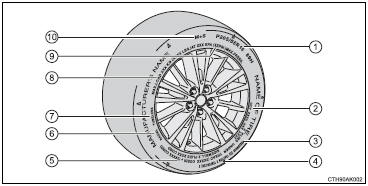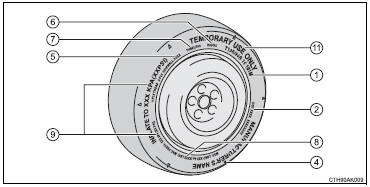Toyota Corolla (E170) 2014–2019 Owners Manual / Vehicle specifications / Specifications / Tire information
Toyota Corolla (E170): Tire information
Typical tire symbols
► Full-size tire

► Compact spare tire

1 Tire size
2 DOT and Tire Identification Number (TIN)
3 Uniform tire quality grading
For details, see “Uniform Tire Quality Grading” that follows.
4 Location of treadwear indicators 5 Tire ply composition and materials Plies are layers of rubber-coated parallel cords. Cords are the strands which form the plies in a tire.
6 Radial tires or bias-ply tires A radial tire has “RADIAL” on the sidewall. A tire not marked “RADIAL” is a bias-ply tire.
7 TUBELESS or TUBE TYPE
A tubeless tire does not have a tube and air is directly put into the tire. A tube
type tire has a tube inside the tire and the tube maintains the air pressure.
8 Load limit at maximum cold tire inflation pressure 9 Maximum cold tire inflation pressure This means the pressure to which a tire may be inflated.
10 Summer tires or all season tires An all season tire has “M+S” on the sidewall. A tire not marked “M+S” is a summer tire.
11 “TEMPORARY USE ONLY”
A compact spare tire is identified by the phrase “TEMPORARY USE ONLY” molded on
its sidewall. This tire is designed for temporary emergency use only.
- Typical DOT and Tire Identification Number (TIN)
- Tire size
- Tire section names
- Uniform Tire Quality Grading
- Glossary of tire terminology
Other materials:
Adding the washer fluid
Add washer fluid in the following
situations:
A washer does not work.
The warning message
appears on the multi-information
display.
WARNING
■When adding washer fluid
Do not add washer fluid when the
engine is hot or running as
washer fluid contains alcohol and
may catch fire if spilled on t ...
Changing gear steps in the M position
To enter 7-speed sport sequential shiftmatic mode, shift the shift lever to M.
Gear steps can then be selected by operating the shift lever, allowing you to drive
in the gear step of your choosing.
1 Upshifting
2 Downshifting
The gear changes once every time the shift lever is operated.
The ...
Circuit description
Refer to dtc c0200/31, c0205/32, c1235/35, c1236/36
Hint:
Dtc no. C0210/33, c1238/38 is for the right rear speed sensor.
Dtc no. C0215/34, c1239/39 is for the left rear speed sensor.
Wiring diagram
...


